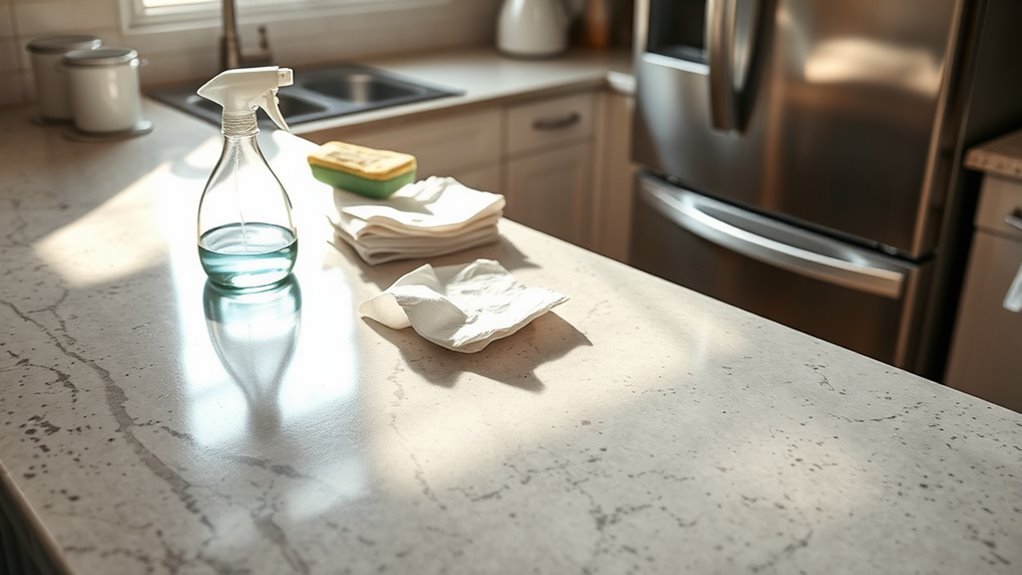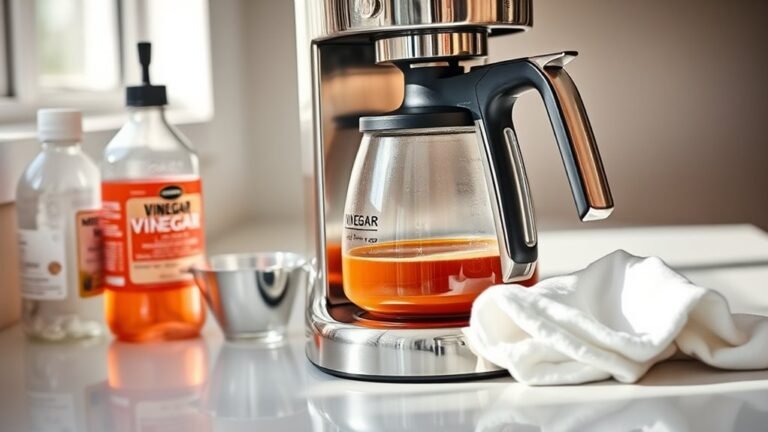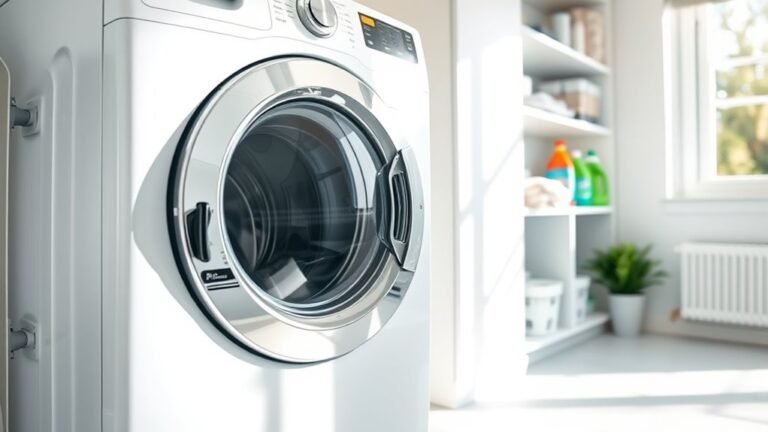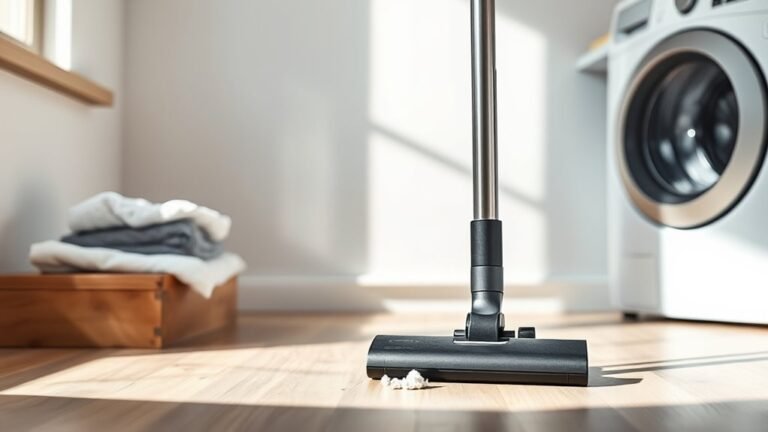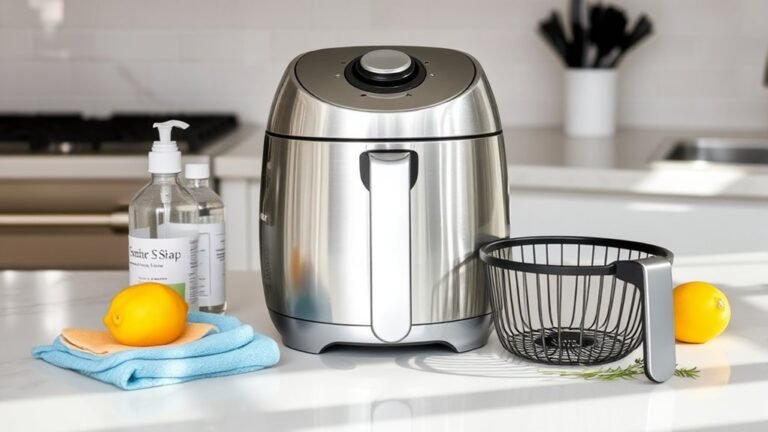Mistakes to Avoid When Cleaning Your Kitchen
When cleaning your kitchen, avoid using harsh chemicals on delicate surfaces—they can cause lasting damage. Don’t forget to regularly sanitize your sponges and cloths to prevent bacteria buildup. Also, clean hidden spots like behind appliances and cabinet tops to stop grime and pests. Keep appliances maintained to extend their life, and practice proper food safety to avoid contamination. Be careful with wooden surfaces—too much water can cause damage. If you want to keep your kitchen spotless and safe, there’s more you’ll want to know.
Using Harsh Chemicals on Delicate Surfaces
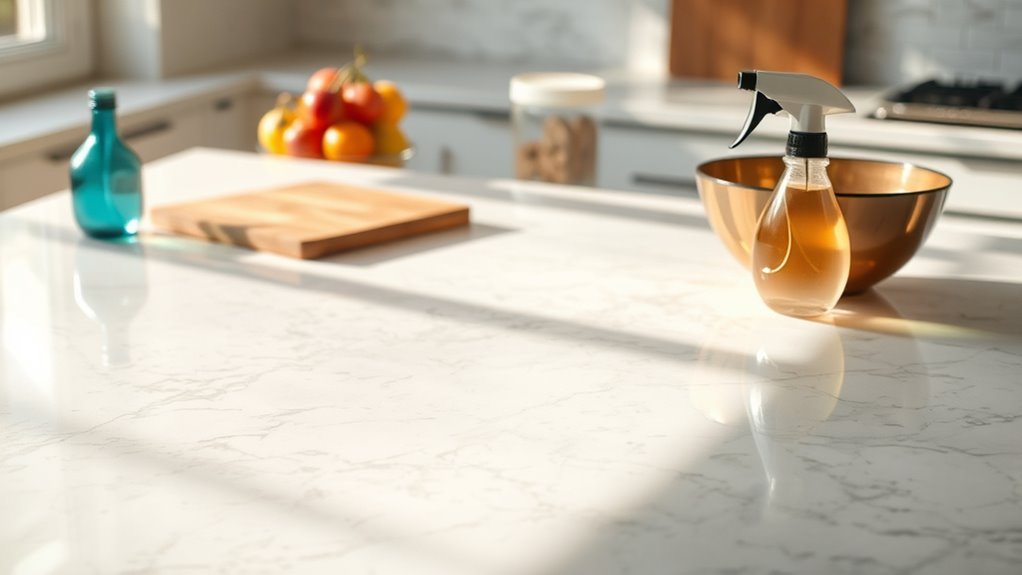
Although it might be tempting to reach for strong cleaners to tackle tough kitchen messes, using harsh chemicals on delicate surfaces can cause lasting damage. You want your kitchen to look great without sacrificing its integrity. Instead of risking scratches or discoloration, opt for delicate surface cleaners designed specifically to protect sensitive materials. These safe cleaning alternatives not only preserve your countertops and appliances but also give you peace of mind. By choosing gentler solutions, you maintain your kitchen’s beauty and functionality while avoiding costly repairs or replacements. Embracing these safer options means you’re in control—free to keep your space spotless without compromising its quality or your health. It’s all about making smart choices that respect both your home and your freedom.
Neglecting to Clean Kitchen Sponges and Cloths
You might not realize it, but your kitchen sponges and cloths can harbor a ton of bacteria if you don’t sanitize them regularly. Skipping this step can turn these cleaning tools into breeding grounds for germs. Make sure you clean them often to keep your kitchen truly sanitary.
Importance of Regular Sanitizing
Because kitchen sponges and cloths constantly come into contact with food residue and moisture, they can quickly become breeding grounds for bacteria if not cleaned regularly. To keep your kitchen safe and fresh, stick to a strict sanitizing schedule. This means setting aside time daily or every few days to thoroughly clean these items. Using effective sanitizers—like diluted bleach solutions or vinegar sprays—ensures you’re actually killing germs rather than just pushing them around. Don’t skip this step just because it seems tedious; your freedom from worry depends on it. Regular sanitizing not only preserves cleanliness but also helps maintain the integrity of your cleaning tools. By committing to this simple routine, you empower yourself to enjoy a kitchen that’s both hygienic and hassle-free.
Risks of Bacterial Build-up
One major risk of neglecting to clean your kitchen sponges and cloths is the rapid buildup of harmful bacteria. These everyday tools, when left damp and dirty, become breeding grounds for bacterial contamination. If you want to keep your kitchen safe and maintain good kitchen hygiene, you can’t afford to overlook this. Using contaminated sponges or cloths spreads germs across surfaces and utensils, putting your health at risk. You deserve a kitchen environment that’s clean and free from hidden dangers. Make it a habit to regularly sanitize or replace your sponges and cloths. By doing so, you take control of your kitchen’s cleanliness and protect yourself and your loved ones from unnecessary bacterial threats. Don’t let neglect compromise your freedom to enjoy a safe, healthy space.
Overlooking Hidden and Hard-to-Reach Areas
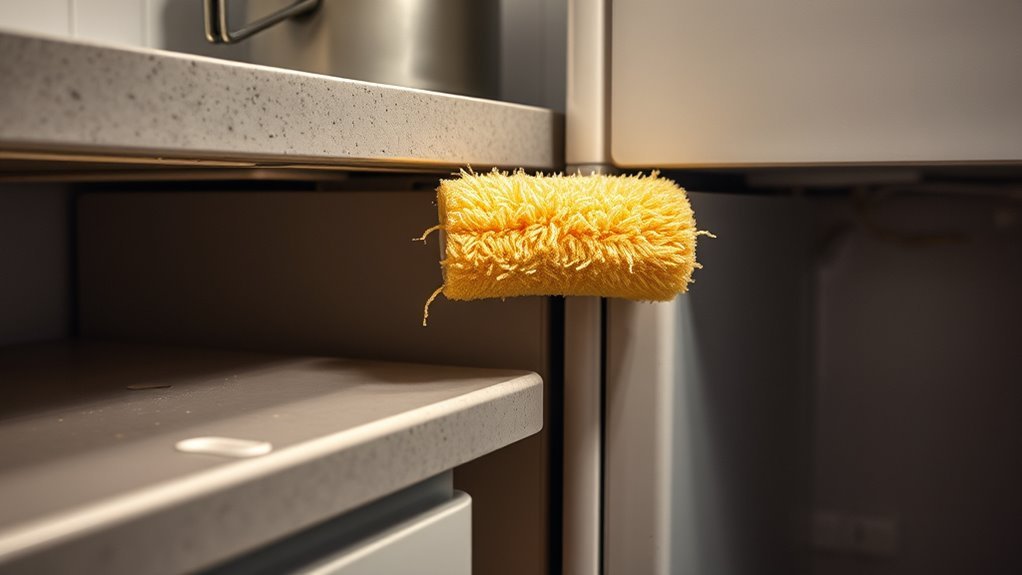
You might forget to clean behind your appliances, where dust and grime love to build up unnoticed. Cabinet tops are another spot that often gets ignored but can collect grease and crumbs over time. Make sure you reach these hidden areas regularly to keep your kitchen truly clean.
Neglecting Behind Appliances
Though it’s easy to focus on visible surfaces, neglecting the space behind appliances can lead to hidden dirt and grime buildup. You might think cleaning the front of your fridge or stove is enough, but behind appliance maintenance is essential to keep your kitchen fresh and hygienic. Dust, food particles, and spills often accumulate in these out-of-sight spots, inviting pests or causing odors. Incorporating simple appliance cleaning techniques, like pulling appliances out carefully and using a vacuum or damp cloth, makes a huge difference. Don’t let this overlooked area trap mess and restrict your kitchen’s freedom. Taking a few extra minutes now saves you from bigger cleaning headaches later, keeping your cooking space truly clean and under your control.
Ignoring Cabinet Tops
While cabinet tops often go unnoticed, they can collect a surprising amount of dust, grease, and crumbs over time. Ignoring these hidden areas means you’re allowing dust accumulation that not only looks messy but can affect air quality and attract pests. Taking a moment to clean your cabinet tops frees you from buildup that’s tough to tackle later. Plus, it’s a chance to reassess your cabinet organization—maybe there’s space to store items better or clear out what you no longer need. Don’t let these hard-to-reach spots become neglected zones in your kitchen cleaning routine. Staying on top of them keeps your kitchen truly fresh and lets you enjoy a cleaner, more open space without unnecessary clutter or hidden grime.
Failing to Regularly Clean Appliances
If appliances aren’t cleaned regularly, grime and food residue can build up quickly, affecting their performance and lifespan. You don’t want your fridge or oven breaking down just because of neglect. Setting a cleaning schedule is key—it keeps you on track and prevents dirt from piling up. Regular appliance maintenance isn’t just about looks; it guarantees everything runs smoothly and saves you money on costly repairs. Take a few minutes each week to wipe down surfaces, clean filters, and check for any issues. By staying consistent, you’re freeing yourself from unexpected breakdowns and keeping your kitchen running like a well-oiled machine. Don’t let forgetting appliance care limit your freedom to cook and enjoy your space.
Ignoring Proper Food Safety and Sanitation Practices
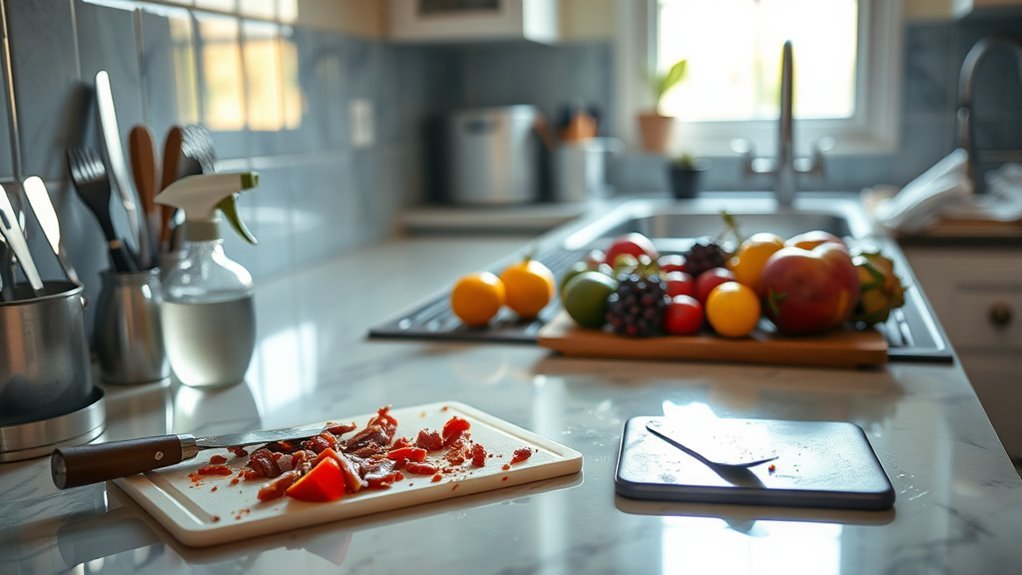
Keeping your appliances clean is just one part of maintaining a healthy kitchen. You’ve got to stay sharp about proper food safety and sanitation practices, too. When you overlook food handling basics, you risk cross contamination that can quickly turn your kitchen into a breeding ground for harmful bacteria. Always wash your hands before and after handling raw meat, and never use the same cutting board for veggies without a good scrub first. Sanitizing surfaces regularly isn’t optional—it’s essential to keep germs at bay. By sticking to these simple habits, you keep your kitchen safe and your freedom intact, avoiding unnecessary illness. Remember, a clean kitchen isn’t just about looks; it’s about protecting yourself and those you care about.
Using Excessive Water on Wooden Surfaces
Because wooden surfaces absorb water easily, using too much liquid during cleaning can cause warping, cracking, or mold growth. To protect your wood and maintain its natural beauty, follow these wood care tips:
- Use a damp, not soaked, cloth to wipe down surfaces—excess water only invites damage.
- Immediately dry any spills or moisture to prevent water from seeping into the grain.
- Apply a quality wood conditioner or oil regularly to reinforce surface protection and keep the wood nourished.
Frequently Asked Questions
How Often Should I Deep Clean My Kitchen Cabinets?
You should deep clean your kitchen cabinets every three to six months to keep things fresh and organized. Sticking to this cabinet cleaning frequency helps maintain your kitchen’s look and hygiene without feeling overwhelming. Incorporate kitchen organization tips like decluttering and wiping down surfaces regularly to make deep cleaning easier. This way, you’ll enjoy a clutter-free space that supports your freedom to cook and relax without stress.
Can I Use Vinegar to Clean Stainless Steel Appliances?
You might think vinegar is some superhero that can clean anything, and honestly, it kind of is! When it comes to stainless steel appliances, vinegar benefits shine by cutting through grime and leaving that sleek, shiny finish you love. Just spray a little on, wipe gently, and watch your stainless steel care routine become effortless. You’ll enjoy a spotless kitchen without harsh chemicals, giving you the freedom to clean smart and stress-free!
What’S the Best Way to Remove Grease Stains From Walls?
When tackling grease removal from walls, you’ll want to mix a solution of warm water, dish soap, and a splash of vinegar for effective wall cleaning. Grab a soft sponge or cloth, dip it in your mix, and gently scrub the greasy spots without damaging the paint. Avoid harsh chemicals that limit your freedom to choose. This easy, natural method helps you reclaim your space with minimal fuss and maximum freshness.
How Do I Prevent Mold Growth in My Kitchen Drains?
To prevent mold growth in your kitchen drains, regular kitchen drain maintenance is key. You’ll want to flush drains with hot water weekly to clear buildup. Using a mixture of vinegar and baking soda helps break down grime and stops mold from forming. Also, avoid letting food scraps sit in the drain, and keep the area dry when possible. These mold prevention tips keep your kitchen fresh and free from unwanted growth.
Are Microfiber Cloths Better Than Paper Towels for Cleaning?
Oh sure, why not stick to paper towels when you can embrace freedom with microfiber cloths? Microfiber benefits include superior absorption and trapping dirt without chemicals, meaning you’re cleaning smarter, not harder. Paper towel drawbacks? They’re wasteful, less durable, and just end up in the trash, limiting your eco-freedom. With microfiber, you’re choosing efficiency, reusability, and a cleaner kitchen that doesn’t chain you to endless rolls of disposable clutter.
